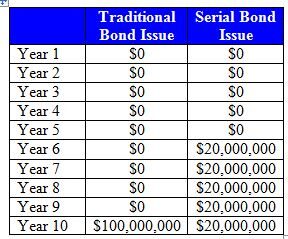What is Balloon Interest?
In the bond world, balloon interest is an increase in the coupon rate of a bond issue corresponding to the maturity of the bond. Serial bonds often use balloon interest.
How Does Balloon Interest Work?
To understand balloon interest, one must first understand serial bonds. The term serial bonds (or installment bonds) describes a bond issue that matures in portions over several different dates.
Normally, when a company or government body issues bonds, all of those bonds mature on the same date (that is, the borrower must repay all of the debt on one particular day). A serial bond issue, however, matures over several periods (usually at regular intervals).
For example, the issuer of $100 million in traditional bonds with 10-year maturities will have to make a $100 million principal payment at the end of the 10th year (see the table below). But the issuer of $100 million in serial bonds might structure the offering such that $20 million matures after five years, another $20 million matures the year after, $20 million the year after that, and so on.

Balloon interest means that the coupon rates on these serial bonds gets progressively higher with maturity. So, the bonds maturing in year 6 might carry a lower coupon rate than the ones that mature in year 7, and year 7's bonds might carry a lower coupon rate than the ones that mature in year 8, and so on.
Why Does Balloon Interest Matter?
Balloon interest encourages bondholders to hold onto debt longer. It can also help the issuer manage its cash flows. Note in the example that the traditional-bond issuer must make coupon payments on $100 million of outstanding debt for a full 10 years, whereas the serial-bond issuer must only do so until year five. After year five, the issuer redeems $20 million of that debt and thus only has to pay interest on $80 million, then $60 million, then $40 million, and so forth. This can represent a considerable cash savings, assuming the issuer is able to make the promised principal repayments, even if the coupon rates get progressively higher.
Serial bonds also allow the issuer to time the maturity dates to the income from the project financed by the bond proceeds. This is why so many municipal bond issues are serial bonds. This strategy requires issuers to complete their projects on time, however.



